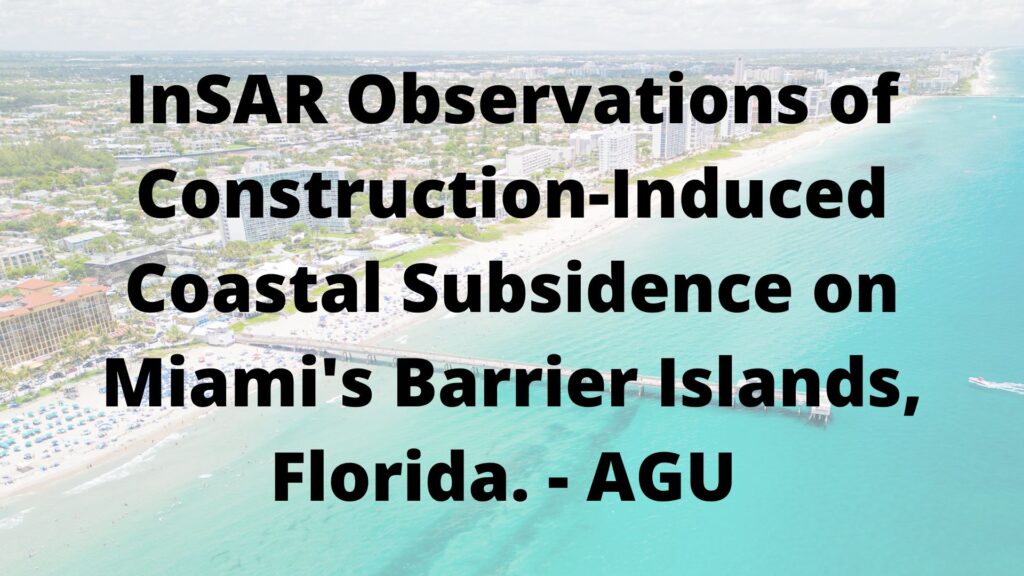The Law Offices of John Caravella, P.C. does not own this research article. This article was published by Farzaneh Aziz Zanjani, Falk Amelung, Andreas Piter, Khaled Sobhan, Amin Tavakkoliestahbanati, Gregor P. Eberli, Mahmud Haghshenas Haghighi, Mahdi Motagh, Pietro Milillo, Sara Mirzaee, Antonio Nanni, Esber Andiroglu. To view the full research article, please click here.
This study utilizes Interferometric Synthetic Aperture Radar (InSAR) to examine subsidence along the coastal strip of the Miami barrier islands from 2016 to 2023. Using Sentinel-1 data, we document vertical displacements ranging from 2 to 8 cm, affecting a total of 35 coastal buildings and their vicinity. About half of the subsiding structures are younger than 2014 and at the majority of them subsidence decays with time. This correlation suggests that the subsidence is related to construction activities. In northern and central Sunny Isles Beach, where 23% of coastal structures were built during the last decade, nearly 70% are experiencing subsidence. The majority of the older subsiding structures show sudden onset or sudden acceleration of subsidence, suggesting that this is due to construction activities in their vicinity; we have identified subsidence at distance of 200 m, possibly up to 320 m, from construction sites. We attribute the observed subsidence to load-induced, prolonged creep deformation of the sandy layers within the limestone, which is accelerated, if not instigated, by construction activities. Distant subsidence from a construction site could indicate extended sandy deposits. Anthropogenic and natural groundwater movements could also be driving the creep deformation. This study demonstrates that high-rise construction on karstic barrier islands can induce creep deformation in sandy layer within the limestone succession persisting for a decade or longer. It showcases the potential of InSAR technology for monitoring both building settlement and structural stability.
Key Points
- We identify a widespread subsidence of up to 8 cm in the vertical direction over the 2016–2023 period in Sunny Isles and Surfside based on Sentinel-1 data
- There is a spatio-temporal correlation between new constructions in the area and subsidence signal
- The subsidence is likely due to prolonged creep deformation of sandy layers within the limestone, affected by construction activities
 John Caravella Esq., is a construction attorney and formerly practicing project architect at The Law Office of John Caravella, P.C., representing architects, engineers, contractors, subcontractors, and owners in all phases of contract preparation, litigation, and arbitration across New York and Florida. He also serves as an arbitrator to the American Arbitration Association Construction Industry Panel. Mr. Caravella can be reached by email: [email protected] or (631) 608-1346.
John Caravella Esq., is a construction attorney and formerly practicing project architect at The Law Office of John Caravella, P.C., representing architects, engineers, contractors, subcontractors, and owners in all phases of contract preparation, litigation, and arbitration across New York and Florida. He also serves as an arbitrator to the American Arbitration Association Construction Industry Panel. Mr. Caravella can be reached by email: [email protected] or (631) 608-1346.
The information provided on this website does not, and is not intended to, constitute legal advice; instead, all information, content, and materials available on this site are for general informational purposes only. Readers of this website should contact their attorney to obtain advice with respect to any particular legal matter. No reader, user, or browser of this site should act or refrain from acting on the basis of information on this site without first seeking legal advice from counsel in the relevant jurisdiction. Only your individual attorney can provide assurances that the information contained herein – and your interpretation of it – is applicable or appropriate to your particular situation. Use of, and access to, this website or any of the links or resources contained within the site do not create an attorney-client relationship between the reader, user, or browser and website authors, contributors, contributing law firms, or committee members and their respective employers.

